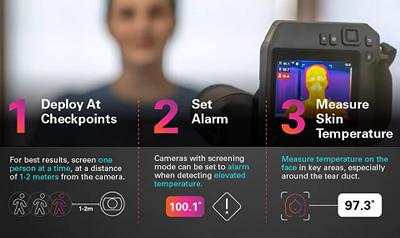Using thermal imaging to screen for fever during COVID-19 with mid-infrared expertise

To enable large numbers of patients and staff entering University Hospital Southampton (UHS) to be rapidly screened for signs of a fever, the head of Clinical Engineering at UHS, Martin Lucey, is convening a team to develop a method for performing non-contact screening. This will check if people entering or leaving the hospital have a raised temperature, one of the main symptoms of COVID-19. People with an elevated temperature can then be taken to one side for more detailed triage, for example a more accurate temperature measurement.

Global-NAMRIP member Dr Dave Rowe, a Research Fellow at the Zepler Institute, is contributing his mid-infrared expertise to the project team. Within the mid-IR lab thermal cameras are used to image photonic devices. An example thermal image of an optical fibre delivering mid-infrared radiation to a photonic device is shown on the right. These same cameras will be used to image body temperature, although the challenge is to use the cameras at a distance of a couple of metres rather than their normal distance of a couple of centimetres. Dave is advising on instrumentation, such as camera specification and the physical setup for the temperature measurement, as well as image processing and data handling for decision making (i.e. whether to ask someone to step aside for further testing).
Illustrating the breadth of activity required during the pandemic, Dave is also volunteering in the lab at the UHS Clinical Research Facility on the COVID-19 vaccine trial, processing blood samples for analysis.